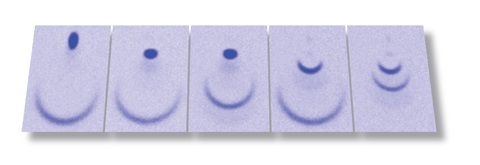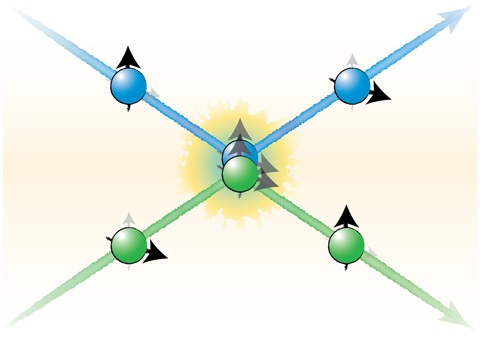3 September 2014
The physical behaviour of materials is strongly governed by the many electrons which can interact and move inside any solid. While an individual electron is a very simple object, carrying only mass, electric charge, and an internal rotation known as “spin”, the collective behaviour of many interacting electrons can be very complex, and understanding it is the key to understanding the properties of the material. The more complex materials, especially those for which the interactions involve the spin of the electrons, pose formidable theoretical challenges. This has prompted researchers in recent years to model such systems, using artificial crystals of light filled with gases of ultracold atoms, in order to mimic the electrons and investigate the collective behaviour in an exceptionally clean environment. Researchers at the Ludwig-Maximilians-University in Munich and at the Max Planck Institute of Quantum Optics led by Simon Fölling and Immanuel Bloch have now succeeded in showing that certain atoms can interact by exchanging their spin even between two different “electron orbital” states, and that they do so in a highly unusual, maximally symmetric fashion (Nature Physics, Advance Online Publication, 31 August 2014). For this, the scientists allowed atoms in several possible combinations of spin orientations to interact in a pair-wise fashion, and then analyzed the result of the interaction and the amount of energy associated with it. The existence of such spin-exchanging interactions and of a high spin symmetry in ytterbium was so far only predicted theoretically, and their experimental characterization paves the way for the experimental study of previously inaccessible quantum phenomena in electronic materials.
Electrons in solid materials can generally be divided into two classes: those which move around easily, and those which don’t. Electrical conductors clearly posses many of the former, while simple insulators generally do not. Things become a lot more interesting when either electrons can “switch” between the classes (as in a semiconductor), or when electrons of the two populations can interact with each other, which happens for example in many magnets. Whether a given electron can move or not is determined by its wave function, sometimes called “orbital”. Generally, any electron can be completely described by stating its position, its orbital state, and the state of its spin. The spin, a property which only exists in the quantum world, is essentially the internal rotation of the particle around an axis. In simple materials such as most insulators and metallic conductors, it plays a relatively minor role in the workings of the material, but for others, such as magnets and superconductors, it is crucially important. While some of these effects are understood well, others still remain mysterious. In the particular case where interactions between co-existing classes of mobile and localized atoms involve the spin, many questions remain despite initial theoretical breakthroughs by Anderson and Kondo in the early 1960’s.
A relatively recent approach to understand complex materials is to simulate those systems by mimicking the crystalline structure and the electrons by means of laser fields and ultracold gases of atoms, and to then replicate the electrons’ interactions by similar interactions between the atoms. In their experiment, Francesco Scazza and co-workers prepared an extremely cold ensemble of fermionic ytterbium ordered in an array of isolated atom pairs, trapped in a crystal of light created by the interference of counter-propagating laser beams. The rare-earth element ytterbium is used because it was predicted that the specific features of its internal structure would allow the precise replication of interactions between mobile and localized electrons. This interaction is a “spin-exchanging” process, where two atoms, upon contact, can exchange the values of their spin property (while keeping their orbital property), in addition to being deflected by each other (see Fig. 1). Such a property was proposed by Kondo to explain dramatic changes in the electric conduction properties of metals, and has since been connected to such effects as the appearance of “heavy electrons” and the emergence of certain types of superconductivity and magnetic order in materials. The model is also relevant in the as-yet mysterious “colossal magnetoresistance” effect, which is being studied by engineers for potential use in novel electronics and “spintronics” devices.
In their experiments, an extremely cold gas of Rubidium atoms was loaded into an optical lattice: a periodic structure of bright and dark areas, created by the interference of counter-propagating laser beams. In this lattice structure, the atoms are held in either dark or bright spots, depending on the wavelength of the light, and therefore align themselves in a regular pattern. The resulting periodic structure of light resembles the geometry of simple solid state crystals where the atoms play the role of the electrons, making it an ideal model system to simulate condensed matter physics. In this case, the experimentalists chose a special lattice configuration, which creates an optical crystal with a ladder-like shape (see Fig. 1).
When ytterbium atoms are used to emulate electrons, the equivalent of the electrons’ spin is their nuclear spin. But since an atom and its nucleus are much more complex than a single electron, the ytterbium spin offers more possibilities. While the electron can only “spin” in either direction around a given axis with a fixed strength, resulting in two possible rotation states, the ytterbium atom can pick one out of up to six possible spin orientations. For most other elements, these spin states are not equivalent, and therefore only two at a time can be present without breaking the fundamental “spin symmetry”, which is called SU(2) in such cases. Ytterbium however belongs to the small group of elements for which this symmetry is observed even with more than two components, and many-body systems with an extended SU(N) symmetry can therefore be realized with this atom. “This is an especially exciting prospect for researchers, as highly unusual and hard-to-predict properties such as exotic ordering behaviour are expected in these systems, which do not occur naturally.” explains Francesco Scazza of the Munich group “It had previously not been proven that the spin-exchange interaction would leave this property intact.”
By probing the isolated atom pairs with an extremely stable laser whose frequency can be controlled to a precision of 12 digits, the Munich team was able to quantitatively measure the spin-exchange interactions and demonstrate their special six-fold spin symmetry, using spin-sensitive preparation and detection methods to separately analyze different spin combinations (see Fig. 2). In addition, Francesco Scazza and colleagues succeeded in directly observing the spin-exchanging process at work in real time, by detecting the evolution of the populations of different spin states.

Fig. 2 The six different spin states of ytterbium atoms can be separated and then imaged. By independently analyzing data from different combinations of states, it can be shown that the behaviour of the gas is symmetric with respect to the choice of spin combinations. (Graphic: LMU-München / MPQ, Quantum Many Body Systems Division)
The experiments represent an important step forward in the quantum simulation of strongly-correlated electron materials with ultracold atoms and open several routes to the observation of complex, and even completely novel phases of matter, ranging from magnets to so-called “heavy fermion” materials, and from spin liquids to exotic magnets with ordering of higher symmetry.
Original publication:
Francesco Scazza, Christian Hofrichter, Moritz Höfer, Pieter De Groot, Immanuel Bloch and Simon Fölling
Observation of two-orbital spin-exchange interactions with ultracold SU(N)-symmetric fermions
Nature Physics, 3061 (2014), Advance Online Publication















